护理英文小讲课
- 格式:ppt
- 大小:275.50 KB
- 文档页数:20
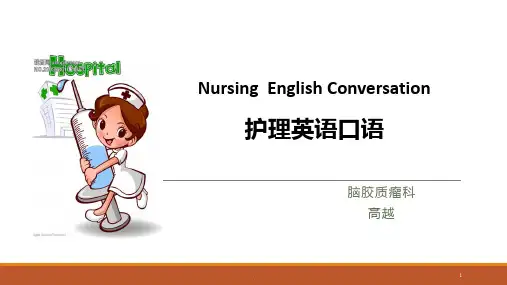

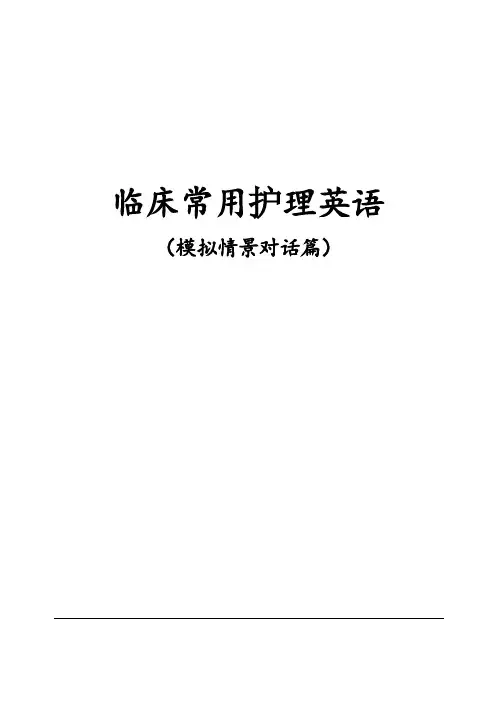
临床常用护理英语(模拟情景对话篇)一、咨询台/问候(Greeting At the Reception Desk)情景一A: Good Morning, my name is Shan, how are you doing? 早上好,我叫姗,你好吗?B: Good Morning, my name is Jack; I am doing fine, and you? 早上好,我叫杰克,我很好,你呢?A: I am fine too. Thank you. Nice to meet you. 我也很好,谢谢。
很高兴认识你。
B: Where are you come from? 你从哪里来。
A: I come from America. 我从美国来。
A: Aha, welcome to China. 哦,欢迎你到中国来。
情景二A: Good morning, Sir. My name is Tracy, How can I help you? 早上好先生,我能帮助您什么吗?B: Good morning, I got fever and feeling awful. 早上好,我发烧了,感觉糟透了。
A: I am sorry to hear about this, please come with me to have a sit over there? 很抱歉听见这个,请跟我过来先坐下。
B: ok, thank you. 好的,谢谢你。
A: You are welcome. Please wait a moment, I will be right back. 不客气,请您稍等,我马上回来。
去拿体温计和登记本A: oh, you got fever. Can you still walk; I will bring you to our medical specialist. 喔,您发烧了。
您还能走路吗,我将带您去我们的医疗专员那里B: Yes, I can. 是的,我还能走。
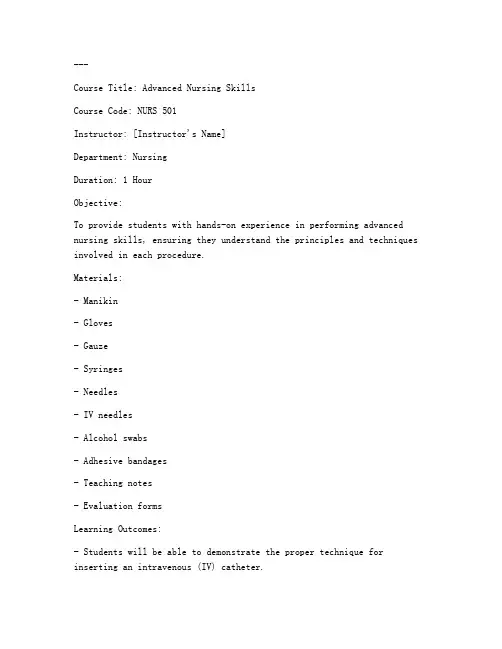
---Course Title: Advanced Nursing SkillsCourse Code: NURS 501Instructor: [Instructor's Name]Department: NursingDuration: 1 HourObjective:To provide students with hands-on experience in performing advanced nursing skills, ensuring they understand the principles and techniques involved in each procedure.Materials:- Manikin- Gloves- Gauze- Syringes- Needles- IV needles- Alcohol swabs- Adhesive bandages- Teaching notes- Evaluation formsLearning Outcomes:- Students will be able to demonstrate the proper technique for inserting an intravenous (IV) catheter.- Students will understand the importance of infection control and patient privacy during the procedure.- Students will be able to perform a physical assessment on a manikin, including vital signs and observation of the patient's condition.---Lesson PlanI. Introduction (5 minutes)- Briefly introduce the topic of advanced nursing skills and its importance in clinical practice.- Explain the objectives of the lesson and the expected learning outcomes.II. Theory (10 minutes)- Discuss the theoretical aspects of the advanced nursing skills to be covered, including:- Insertion of an intravenous catheter- Infection control and patient privacy- Physical assessment techniquesIII. Demonstration (15 minutes)- Demonstrate the correct technique for inserting an IV catheter on the manikin.- Emphasize the importance of infection control, such as hand hygiene and the use of alcohol swabs.- Show how to perform a physical assessment, including taking vital signs and observing the patient's condition.IV. Practice (30 minutes)- Allow students to practice the insertion of an IV catheter on the manikin.- Circulate among the students to provide individual guidance and correct any techniques that are not performed correctly.- Instruct students on how to maintain patient privacy and infection control during the procedure.V. Physical Assessment Practice (15 minutes)- Have students perform a physical assessment on the manikin, including taking vital signs and observing the patient's condition.- Provide feedback and guidance as needed.VI. Conclusion (5 minutes)- Review the key points covered during the lesson.- Address any questions or concerns from the students.- Collect evaluation forms to assess the effectiveness of the lesson.---EvaluationStudents will be evaluated on their ability to:- Demonstrate the correct technique for inserting an IV catheter.- Maintain infection control and patient privacy during the procedure.- Perform a physical assessment on a manikin, including vital signs and observation of the patient's condition.Grading Criteria:- Technique (50%)- Infection control and patient privacy (20%)- Physical assessment skills (30%)---Sample Student ActivityStudent's Name: [Student's Name]Skill Practiced: Insertion of an IV catheterObservations:- The student correctly donned gloves and performed hand hygiene.- The student used the appropriate technique for inserting the IV catheter, including proper positioning of the patient and use of the tourniquet.- The student demonstrated a good understanding of infection control principles, such as the use of alcohol swabs.- The student was able to successfully insert the IV catheter and infuse fluid.Comments:- The student performed the skill with confidence and demonstrated a good understanding of the principles involved.- Further practice is recommended to improve technique and ensure consistency.---This template and sample can be adapted to fit various advanced nursing skills and courses.。

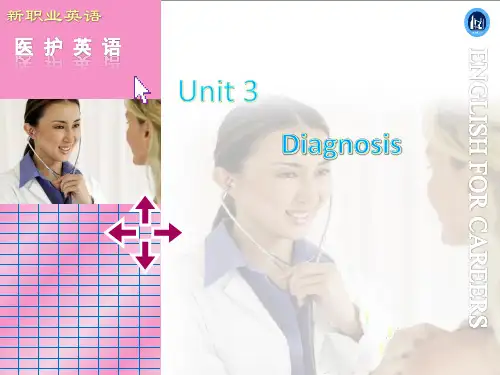

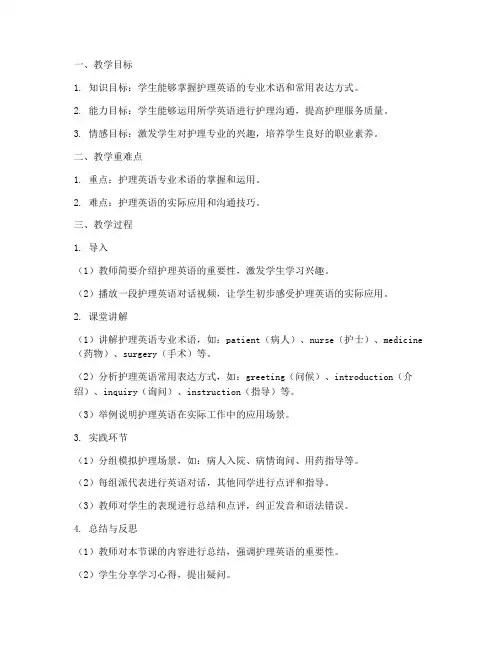
一、教学目标1. 知识目标:学生能够掌握护理英语的专业术语和常用表达方式。
2. 能力目标:学生能够运用所学英语进行护理沟通,提高护理服务质量。
3. 情感目标:激发学生对护理专业的兴趣,培养学生良好的职业素养。
二、教学重难点1. 重点:护理英语专业术语的掌握和运用。
2. 难点:护理英语的实际应用和沟通技巧。
三、教学过程1. 导入(1)教师简要介绍护理英语的重要性,激发学生学习兴趣。
(2)播放一段护理英语对话视频,让学生初步感受护理英语的实际应用。
2. 课堂讲解(1)讲解护理英语专业术语,如:patient(病人)、nurse(护士)、medicine (药物)、surgery(手术)等。
(2)分析护理英语常用表达方式,如:greeting(问候)、introduction(介绍)、inquiry(询问)、instruction(指导)等。
(3)举例说明护理英语在实际工作中的应用场景。
3. 实践环节(1)分组模拟护理场景,如:病人入院、病情询问、用药指导等。
(2)每组派代表进行英语对话,其他同学进行点评和指导。
(3)教师对学生的表现进行总结和点评,纠正发音和语法错误。
4. 总结与反思(1)教师对本节课的内容进行总结,强调护理英语的重要性。
(2)学生分享学习心得,提出疑问。
(3)教师解答学生疑问,并对学生的表现进行评价。
四、教学资源1. 教材:护理英语专业教材。
2. 教学课件:护理英语常用词汇和表达方式。
3. 实践场景:模拟病房、病人角色扮演等。
五、教学评价1. 课堂参与度:观察学生在课堂上的表现,如:发言积极性、实践环节的参与度等。
2. 作业完成情况:检查学生的课后练习和作业完成情况。
3. 考试:进行护理英语测试,考察学生的实际应用能力。
英语护理授课教案范文:一、教学目标1. 知识目标:学生能够掌握护理英语的专业术语,如:surgery(手术)、operation(手术)、anesthesia(麻醉)等。
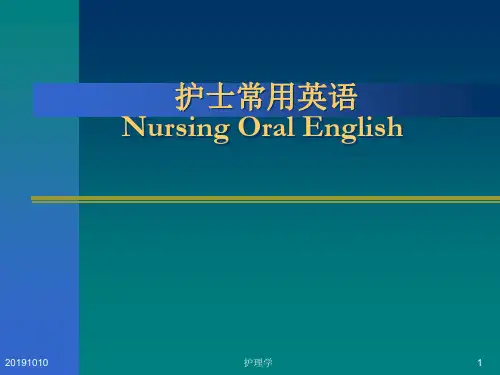

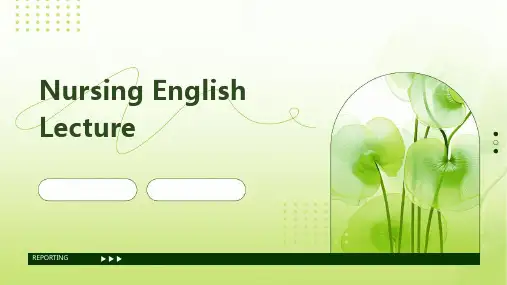
护理英文教案模板范文 Nursing Care Plan Template Outline.1. Patient Information:Name.Medical Record Number.Date of Birth.Age.Gender.Primary Diagnosis.Reason for Admission.2. Nursing History:Present Health History.Past Medical History.Surgical History.Medications.Allergies.Social History.Family History.Cultural Considerations.3. Physical Assessment:General Appearance: Vital signs, level of consciousness.Skin: Color, texture, turgor, lesions.Head, Neck, and Lymph Nodes: Symmetry, masses, tenderness.Respiratory: Rate, rhythm, depth, breath sounds.Cardiovascular: Heart rate, rhythm, auscultation findings.Gastrointestinal: Abdomen, bowel sounds, masses.Genitourinary: Urine output, color, clarity.Musculoskeletal: Range of motion, pain, strength.Neurological: Orientation, reflexes, sensation.4. Nursing Diagnoses: Actual or potential health problems.5. Goals for Care: Expected outcomes.6. Interventions: Actions to achieve goals.7. Evaluation: Ongoing assessment of progress and outcomes.护理计划模板详解。
护士英文讲课稿范文带翻译Good morning, everyone! Today, I am going to talk about the roles and responsibilities of a nurse in the healthcare system. As a nurse, we play a vital role in patient care and have a significant impact on their overall experience at the hospital. I will discuss the various aspects of nursing, including patient advocacy, education, collaboration, and leadership.Firstly, let's talk about patient advocacy. As nurses, we are the primary advocates for our patients. It is our responsibility to ensure that their voice is heard and their needs are met. We act as a liaison between the patient and the healthcare team, ensuring that the patient's preferences and values are taken into consideration when making decisions about their care. This includes advocating for the patient's rights, ensuring they receive appropriate and timely care, and addressing any concerns or issues they may have.Secondly, a crucial role of nurses is patient education. We provide education to patients and their families about their condition, treatment plans, and self-care techniques. By doing this, we empower the patients to actively participate in their own care, leading to better patient outcomes. It is essential to communicate information in a clear and understandable manner, using plain language and avoiding medical jargon. Patient education also includes teaching patients about preventive measures and promoting healthy lifestyle choices.Next, collaboration is another essential aspect of nursing. Nurses work closely with other healthcare professionals, including doctors, therapists, and social workers, to provide comprehensive patientcare. Through effective communication and teamwork, we ensure that the patient's needs are met in a coordinated and holistic manner. Collaboration also involves sharing information and expertise, seeking help or guidance when needed, and being open to feedback from colleagues. By working collaboratively, we can provide the best possible care for our patients.In addition to collaboration, nursing also requires strong leadership skills. Nurses often find themselves in positions of leadership, whether it be leading a team of healthcare professionals or taking charge in emergency situations. Leadership in nursing involves being proactive, making informed decisions, and advocating for change when necessary. It also includes being a role model for other nurses and fostering a positive work environment.Furthermore, nursing involves providing emotional support to patients and their families. In many instances, patients may be scared, anxious, or in pain. It is our role as nurses to provide a comforting and compassionate presence, offering empathy and understanding. We should always prioritize the patient's emotional well-being and take the time to listen to their concerns and fears. By providing emotional support, we can help alleviate the patients' anxiety and contribute to their overall healing process.Lastly, nurses are responsible for maintaining accurate and detailed patient records. Documentation is a vital part of nursing practice and ensures continuity of care. It includes recording the patient's medical history, medications, treatments, and any observations or assessments. Accurate documentation also helps in the evaluation of patient progress and serves as legal evidence if needed.In conclusion, nursing is a multifaceted profession that requires a variety of skills and responsibilities. We serve as advocates for our patients, educating and empowering them to take control of their own health. Collaboration with other healthcare professionals is essential for providing comprehensive care, while leadership skills enable us to make critical decisions and effect positive change. Emotional support and attentive documentation round out the roles and responsibilities of a nurse. Remember, as nurses, we have the power to make a significant difference in the lives of our patients, and that is a privilege and responsibility we should not take lightly. Thank you.大家早上好!今天我要谈谈护士在医疗系统中的角色和责任。